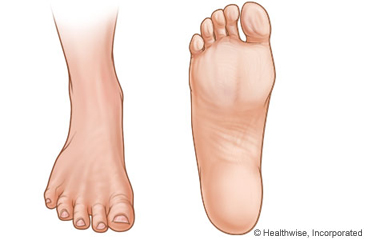
Your Care Instructions
A foot sprain occurs when you stretch or tear the ligaments around your foot. Ligaments are the tough tissues that connect one bone to another. A sprain can happen when your child runs, falls, or hits a toe against something. Sprains often happen when a child jumps or changes direction quickly. This may occur when your child plays basketball, soccer, or other sports.
Most foot sprains will get better with treatment at home.
Follow-up care is a key part of your child's treatment and safety. Be sure to make and go to all appointments, and call your doctor if your child is having problems. It's also a good idea to know your child's test results and keep a list of the medicines your child takes.
How can you care for your child at home?
- Let your child walk or put weight on the sprained foot as long as it does not hurt.
- If your doctor gave your child a splint or immobilizer, have your child wear it as directed. If your child was given crutches, have your child use them as directed.
- Put ice or a cold pack on your child's foot for 10 to 20 minutes at a time. Try this every 1 to 2 hours for 3 days when your child is awake. Put a thin cloth between the ice pack and your child's skin. Keep your child's splint dry.
- After 2 or 3 days, you can try applying heat to the area that hurts. Apply heat for 10 to 20 minutes at a time, several times a day. Put a thin cloth between the heat and your child's skin. You might also try switching between ice and heat.
- Prop up the sore foot on a pillow when you ice it or anytime your child sits or lies down during the next 3 days. Try to keep it above the level of your child's heart. This will help reduce swelling.
- Be safe with medicines. Read and follow all instructions on the label.
- If your child is not taking a prescription pain medicine, ask the doctor if your child can take an over-the-counter medicine.
- If the doctor gave your child a prescription medicine for pain, give it as prescribed.
- Store your prescription pain medicines where no one else can get to them. When you are done using them, dispose of them quickly and safely. Your local pharmacy or hospital may have a drop-off site.
- Help your child do any exercises that your doctor or physical therapist suggests.
- Have your child return to their usual exercise gradually as they feel better.
When should you call for help?
Call your doctor now or seek immediate medical care if:
- Your child has increased or severe pain.
- Your child's toes are cool or pale or change color.
- Your child's wrap or splint feels too tight.
- Your child has tingling, weakness, or numbness in a leg or foot.
Watch closely for changes in your child's health, and be sure to contact your doctor if:
- Your child cannot put any weight on the foot.
- Your child gets a fever.
- Your child does not get better as expected.
Where can you learn more?
Go to http://www.healthwise.net/patientEd
Enter I303 in the search box to learn more about "Foot Sprain in Children: Care Instructions".
Current as of: July 31, 2024
Author: Ignite Healthwise, LLC Staff
Clinical Review Board
All Ignite Healthwise, LLC education is reviewed by a team that includes physicians, nurses, advanced practitioners, registered dieticians, and other healthcare professionals.

